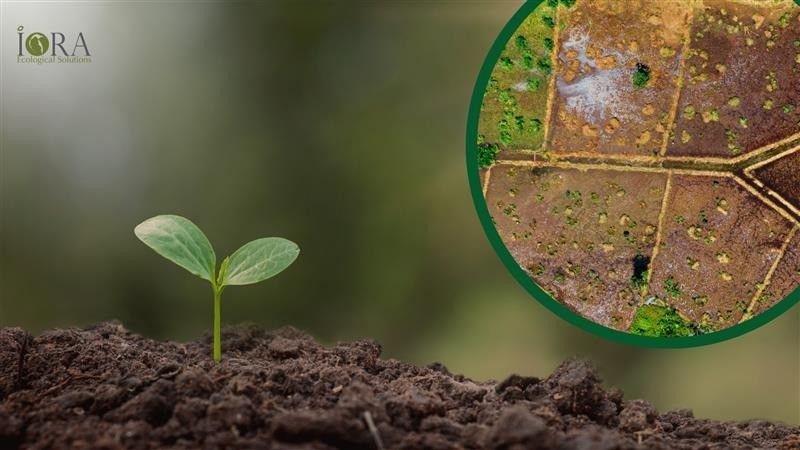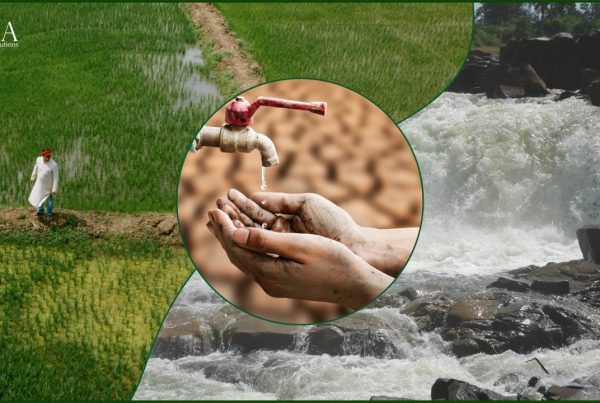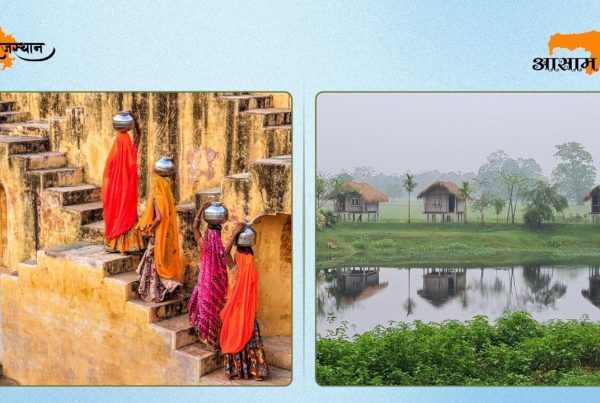India’s relationship with land runs deep. It feeds millions, anchors livelihoods, and shapes centuries-old cultural identities. But today, this vital resource is under severe stress. India is confronting a serious land degradation, with nearly 120.7 million hectares—about one-third of its total land area—already degraded. Alarmingly, 85.7 M ha are impacted by soil erosion caused by water and wind.
The impact is most visible in agriculture—India’s backbone. With over 40% of the population relying on it for livelihoods, farming is more than just an economic activity, it a way of life deeply rooted in tradition and community. However, widespread land degradation is threatening this foundation, jeopardising food security, worsening poverty, and forcing rural migration.
But this isn’t India’s crisis alone.
Land degradation is a global crisis, affecting more than 3 billion people and putting nearly US$44 trillion in economic output at risk.
The Alarming Scale of India’s Land Degradation Crisis
Between 2001 and 2021, India lost more than 2.07 M ha of tree cover, a trend that signals not just an ecological balance but also deepening vulnerability. The causes are many: intensive rainfall, uncontrolled grazing across 5.65 M ha, excessive chemical fertiliser use (32 million tons annually), and shifting cultivation practices on 7.6 M ha.
According to the Space Applications Centre (SAC, 2021) 97.8 M ha (29.7%) of India’s land now stands degraded. Arid and semi-arid regions like Rajasthan, Gujarat, Maharashtra’s Marathwada, Andhra Pradesh, and Karnataka are among the hardest hit. The World Drought Atlas (UNCCD COP-16, 2024) and ISRO’s NRSC data mark these areas as hotspots, with Rajasthan’s Thar Desert and Marathwada emerging as critical zones for soil erosion, water scarcity, and declining productivity.

Transforming Landscapes for a Sustainable Future
Healthy landscapes provide essential ecosystem services, from provisioning food, clean water, and raw materials to supporting biodiversity and sequestering carbon to mitigate climate change. Amidst growing pressures from degradation, restoring these landscapes offers the opportunity to transform livelihoods and enhance resilience to climate change. For instance, rehabilitating watersheds improves water availability which in turn will boost agricultural productivity and maximise alternative income opportunities like fisheries, agroforestry, or non-timber forest products (such as medicinal plants or honey).
The global community is stepping up to support this vision. At the recent United Nations Convention to Combat Desertification (UNCCD) COP16, governments, development banks, and international organisations pledged over US$12 billion to finance land restoration efforts, signalling a collective commitment to achieving Land Degradation Neutrality (LDN) by 2030.
India, too, has set an ambitious target to restore 26 M ha of degraded land by the same deadline, aligning with the Bonn Challenge and the UNCCD. So far, 18.94 M ha of land has already been restored, a major stride forward. (PIB, 2024). But the road ahead is long.
Policy meets Purpose: India’s Restoration Framework
India’s policy framework is well aligned with its restoration goals. The 1988 National Forest Policy (NFP) targets one-third forest cover, promoting afforestation, reforestation, and sustainable management with community and biodiversity focus, funded by central/state budgets and CAMPA. The National Mission for a Green India (GIM) aims to afforest 10 M ha by 2030, supporting agroforestry and watershed management with diverse funding, including green bonds and carbon credits, while the National Afforestation Programme (NAP) fosters community-led afforestation.
Meanwhile, the Watershed Development Programme has helped conserve soil and water in rainfed areas, and the Namami Gange Programme, with its $4.25 billion budget, is restoring the Ganges basin with 230 organisations.
Innovative Financing: Paving the Way for Restoration
But policy alone is not enough. Restoring millions of hectares requires substantial capital and innovation. And here, India is charting new models that treat nature as an investable asset. Models that blend environmental ambition with economic pragmatism. Models that ask: What if restoring land could pay?
The Green Credit Programme, launched in 2023, is a first of its kind effort that incentivises individuals, businesses and local bodies actions for environmentally sustainable and responsive actions by like afforestation, soil conservation, and watershed management. The programme assigns participants tradable credits which can be converted into financial benefits. This market-based approach encourages private sector participation and empowers communities to take ownership of restoration efforts.
Equally transformative is the Payment for Ecosystem Services (PES) model. At its core, PES compensates landowners for maintaining ecosystem services like clean water, carbon sequestration, or biodiversity conservation. PES brings a profound shift in how we value the world around us. Clean water, carbon sequestration, biodiversity, these aren’t free services; they’re the lifelines of our future. And PES puts money where our survival is, creating a win-win scenario, blending environmental stewardship with economic stability.
In Meghalaya, the state’s GREEN initiative has helped conserve 54,000 ha of community-owned forests through PES, protecting biodiversity while supporting local livelihoods. Similarly, in Palampur, Himachal Pradesh, a 20-year PES agreement between the municipal corporation and the Village Forest Development Society safeguards local forests and springs, ensuring water security for the region. That’s climate resilience, made tangible.
Experts from organisations like IORA, as part of their varied assignments, are scaling up these efforts, taking these concepts from pilot to scale. In Himachal Pradesh, our experts have designed PES mechanisms that link ecological protection with real-world economic benefits. Backed by robust scientific research, their valuation studies—ranging from the forests of Himachal Pradesh to India’s iconic tiger reserves—quantify the hidden economic worth of ecosystems. Their ecosystem service valuation studies, such as those assessing Himachal Pradesh’s forests (Verma et al., 2016) and India’s tiger reserves (Verma et al., 2015, 2019), quantify the economic value of natural ecosystems, providing critical insights for evidence-based policymaking. By demonstrating the tangible benefits of conservation, these studies lay the groundwork for scalable, impactful restoration strategies.
A Call for Collective Action
By committing to restore 26 M ha by 2030, supporting innovative financing mechanisms like PES and the Green Credit Programme, and championing policies like GIM, NAP, and Namami Gange, India has the chance to lead the global fight against land degradation. Combating desertification and drought requires a united effort from all: governments must strengthen policies, streamline regulations, and allocate funds to meet LDN targets. NGOs can bridge the gap by between plans and action, communities, particularly women and indigenous groups, must be empowered with land rights, resources, and training to lead restoration efforts. And the private sector, which currently contributes only 6% of global restoration funding (UNCCD, 2024), has a unique opportunity to step up through investments in sustainable practices, green technologies, and corporate social responsibility initiatives.
The World Day to Combat Desertification and Drought 2025 is our moment to galvanise action. This isn’t just about saving land—it’s about securing food security, creating sustainable livelihoods, and building climate resilience for generations to come.
Whether you’re a policymaker, a community leader, or an individual passionate about the environment, your actions matter. Let’s come together to transform India’s degraded landscapes into thriving ecosystems. Support local restoration projects, advocate for sustainable policies, and explore opportunities like agroforestry, sustainable farming, or eco-tourism. Together, we can restore India’s land, unlock its vast potential, and build a future where the land is not just preserved but celebrated as the bedrock of life, livelihoods, and prosperity.
References:
- https://ntca.gov.in/assets/uploads/Reports/EconEval/Economic_evaluation_TR.pdf
- https://ntca.gov.in/assets/uploads/Reports/EconEval/Economic_evaluation_phaseII.pdf
- https://www.scribd.com/document/421691705/Ecosystem-Services-Valuation-of-Forests-of-Himachal-Pradesh
- https://www.nature.com/articles/s41597-023-02856-y
- https://www.agriinsights.in/2024/11/agriculture-profile-of-india.html
- https://vedas.sac.gov.in/static/atlas/dsm/DLD_Atlas_SAC_2021.pdf
- https://www.frontiersin.org/journals/ecology-and-evolution/articles/10.3389/fevo.2023.1088796/full
- https://www.unccd.int/news-stories/press-releases/flagship-geo-initiative-will-accelerate-land-restoration-through-better
- https://indiadroughtatlas.in/
- https://www.pib.gov.in/PressReleasePage.aspx?PRID=2078355#:~:text=India%20has%20committed%20to%20restoring%2026%20million%20hectares,to%20restore%2018.94%20million%20hectares%20of%20degraded%20land
- https://www.unccd.int/cop16/focus-areas/land-restoration
- https://moef.gov.in/uploads/2019/06/nfp.pdf
- https://moef.gov.in/uploads/2017/08/GIM_Mission-Document-1.pdf
- https://www.pib.gov.in/PressReleasePage.aspx?PRID=2078355






